
aistore
AIStore: scalable storage for AI applications
Stars: 1596
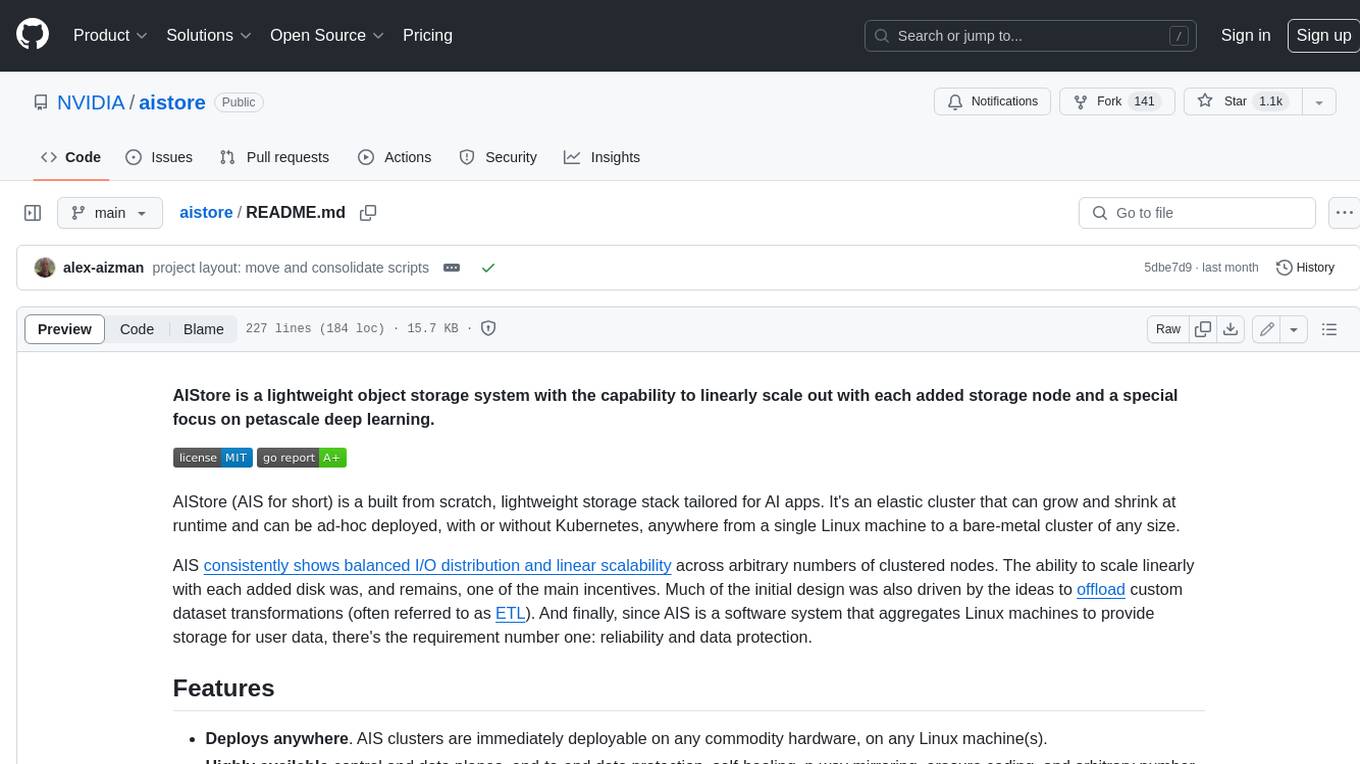
AIStore is a lightweight object storage system designed for AI applications. It is highly scalable, reliable, and easy to use. AIStore can be deployed on any commodity hardware, and it can be used to store and manage large datasets for deep learning and other AI applications.
README:
AIStore: High-Performance, Scalable Storage for AI Workloads
AIStore (AIS) is a lightweight distributed storage stack tailored for AI applications. It's an elastic cluster that can grow and shrink at runtime and can be ad-hoc deployed, with or without Kubernetes, anywhere from a single Linux machine to a bare-metal cluster of any size. Built from scratch, AIS provides linear scale-out, consistent performance, and a flexible deployment model.
AIS consistently shows balanced I/O distribution and linear scalability across an arbitrary number of clustered nodes. The system supports fast data access, reliability, and rich customization for data transformation workloads.
- ✅ Multi-Cloud Access: Seamlessly access and manage content across multiple cloud backends (including AWS S3, GCS, Azure, OCI), with the additional benefit of fast-tier performance and configurable data redundancy.
- ✅ Deploy Anywhere: AIS runs on any Linux machine, virtual or physical. Deployment options range from a single Docker container and Google Colab to petascale Kubernetes clusters. There are no built-in limitations on deployment size or functionality.
- ✅ High Availability: Redundant control and data planes. Self-healing, end-to-end protection, n-way mirroring, and erasure coding. Arbitrary number of lightweight access points.
- ✅ HTTP-based API: A feature-rich, native API (with user-friendly SDKs for Go and Python), and compliant Amazon S3 API for running unmodified S3 clients.
- ✅ Monitoring: Comprehensive observability with integrated Prometheus metrics, Grafana dashboards, detailed logs with configurable verbosity, and CLI-based performance tracking for complete cluster visibility and troubleshooting. See Observability for details.
- ✅ Unified Namespace: Attach AIS clusters together to provide fast, unified access to the entirety of hosted datasets, allowing users to reference shared buckets with cluster-specific identifiers.
- ✅ Turn-key Cache: In addition to robust data protection features, AIS offers a per-bucket configurable LRU-based cache with eviction thresholds and storage capacity watermarks.
- ✅ ETL Offload: Execute I/O intensive data transformations close to the data, either inline (on-the-fly as part of each read request) or offline (batch processing, with the destination bucket populated with transformed results).
- ✅ Existing File Datasets: Ingest file datasets from any local or remote source, either on-demand (ad-hoc) or through asynchronous batch.
- ✅ Data Consistency: Guaranteed consistency across all gateways, with write-through semantics in presence of remote backends.
- ✅ Small File Optimization: AIS supports TAR, ZIP, TAR.GZ, and TAR.LZ4 serialization for batching and processing small files. Features include initial sharding, distributed shuffle (re-sharding), appending to existing shards, listing contained files, and more.
- ✅ Kubernetes: For production deployments, we developed the AIS/K8s Operator. A dedicated GitHub repository contains Ansible scripts, Helm charts, and deployment guidance.
- ✅ Authentication and Access Control: OAuth 2.0-compatible authentication server (AuthN)1.
- ✅ Batch Jobs: Start, monitor, and control cluster-wide batch operations.
The feature set is actively growing and also includes: adding/removing nodes at runtime, managing TLS certificates at runtime, listing, copying, prefetching, and transforming virtual directories, executing presigned S3 requests, adaptive rate limiting, and more.
For the original white paper and design philosophy, please see AIStore Overview, which also includes high-level block diagram, terminology, APIs, CLI, and more. For our 2024 KubeCon presentation, please see AIStore: Enhancing petascale Deep Learning across Cloud backends.
AIS includes an integrated, scriptable CLI for managing clusters, buckets, and objects, running and monitoring batch jobs, viewing and downloading logs, generating performance reports, and more:
$ ais <TAB-TAB>
advanced cluster etl ls remote-cluster space-cleanup
alias config evict ml rmb start
archive cp get object rmo stop
auth create help performance scrub storage
blob-download download job prefetch search tls
bucket dsort log put show waitAIS runs natively on Kubernetes and features open format - thus, the freedom to copy or move your data from AIS at any time using the familiar Linux tar(1), scp(1), rsync(1) and similar.
For developers and data scientists, there's also:
- Go API used in CLI and benchmarking tools
- Python SDK + Reference Guide
- PyTorch integration and usage examples
- Boto3 support
- Read the Getting Started Guide for a 5-minute local install, or
- Run a minimal AIS cluster consisting of a single gateway and a single storage node, or
- Clone the repo and run
make kill cli aisloader deployfollowed byais show cluster
AIS deployment options, as well as intended (development vs. production vs. first-time) usages, are all summarized here.
Since the prerequisites essentially boil down to having Linux with a disk the deployment options range from all-in-one container to a petascale bare-metal cluster of any size, and from a single VM to multiple racks of high-end servers. Practical use cases require, of course, further consideration.
Some of the most popular deployment options include:
| Option | Use Case |
|---|---|
| Local playground | AIS developers or first-time users, Linux or Mac OS. Run make kill cli aisloader deploy <<< $'N\nM', where N is a number of targets, M is a number of gateways
|
| Minimal production-ready deployment | This option utilizes preinstalled docker image and is targeting first-time users or researchers (who could immediately start training their models on smaller datasets) |
| Docker container | Quick testing and evaluation; single-node setup |
| GCP/GKE automated install | Developers, first-time users, AI researchers |
| Large-scale production deployment | Requires Kubernetes; provided via ais-k8s |
For performance tuning, see performance and AIS K8s Playbooks.
AIS supports multiple ingestion modes:
- ✅ On Demand: Transparent cloud access during workloads.
- ✅ PUT: Locally accessible files and directories.
- ✅ Promote: Import local target directories and/or NFS/SMB shares mounted on AIS targets.
- ✅ Copy: Full buckets, virtual subdirectories (recursively or non-recursively), lists or ranges (via Bash expansion).
- ✅ Download: HTTP(S)-accessible datasets and objects.
- ✅ Prefetch: Remote buckets or selected objects (from remote buckets), including subdirectories, lists, and/or ranges.
- ✅ Archive: Group and store related small files from an original dataset.
You can install the CLI and benchmarking tools using:
./scripts/install_from_binaries.sh --helpThe script installs aisloader and CLI from the latest or previous GitHub release and enables CLI auto-completions.
PyTorch integration is a growing set of datasets (both iterable and map-style), samplers, and dataloaders:
- Taxonomy of abstractions and API reference
- AIS plugin for PyTorch: usage examples
- Jupyter notebook examples
Let others know your project is powered by high-performance AI storage:
[](https://github.com/NVIDIA/aistore)- Overview and Design
- Getting Started
- Buckets and Bucket Management
- Observability
- Technical Blog
- S3 Compatibility
- Batch Jobs
- Performance and CLI: performance
- CLI Reference
- Authentication1
- Production Deployment: Kubernetes Operator, Ansible Playbooks, Helm Charts, Monitoring
- See Extended Index
- Use CLI
searchcommand, e.g.:ais search copy - Clone the repository and run
git grep, e.g.:git grep -n out-of-band -- "*.md"
MIT
Alex Aizman (NVIDIA)
For Tasks:
Click tags to check more tools for each tasksFor Jobs:
Alternative AI tools for aistore
Similar Open Source Tools

aistore
AIStore is a lightweight object storage system designed for AI applications. It is highly scalable, reliable, and easy to use. AIStore can be deployed on any commodity hardware, and it can be used to store and manage large datasets for deep learning and other AI applications.
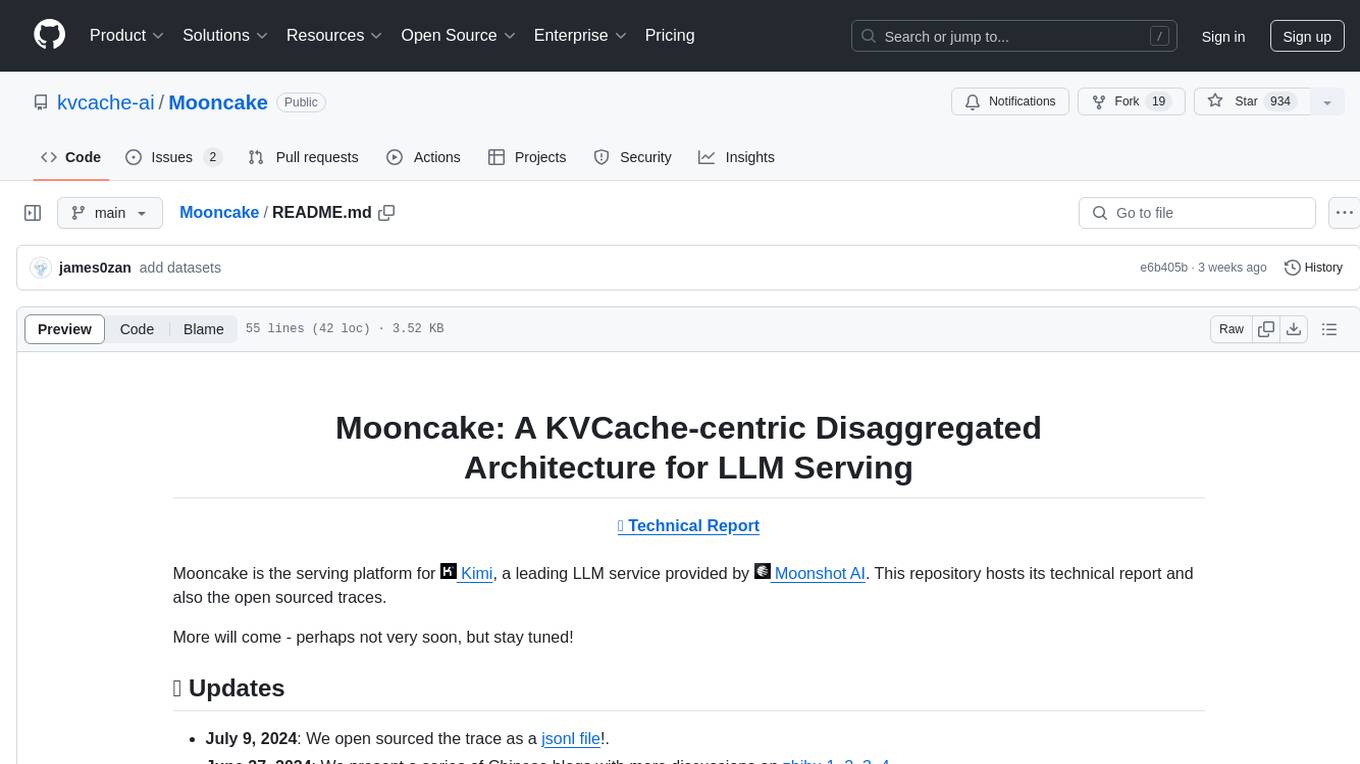
Mooncake
Mooncake is a serving platform for Kimi, a leading LLM service provided by Moonshot AI. It features a KVCache-centric disaggregated architecture that separates prefill and decoding clusters, leveraging underutilized CPU, DRAM, and SSD resources of the GPU cluster. Mooncake's scheduler balances throughput and latency-related SLOs, with a prediction-based early rejection policy for highly overloaded scenarios. It excels in long-context scenarios, achieving up to a 525% increase in throughput while handling 75% more requests under real workloads.
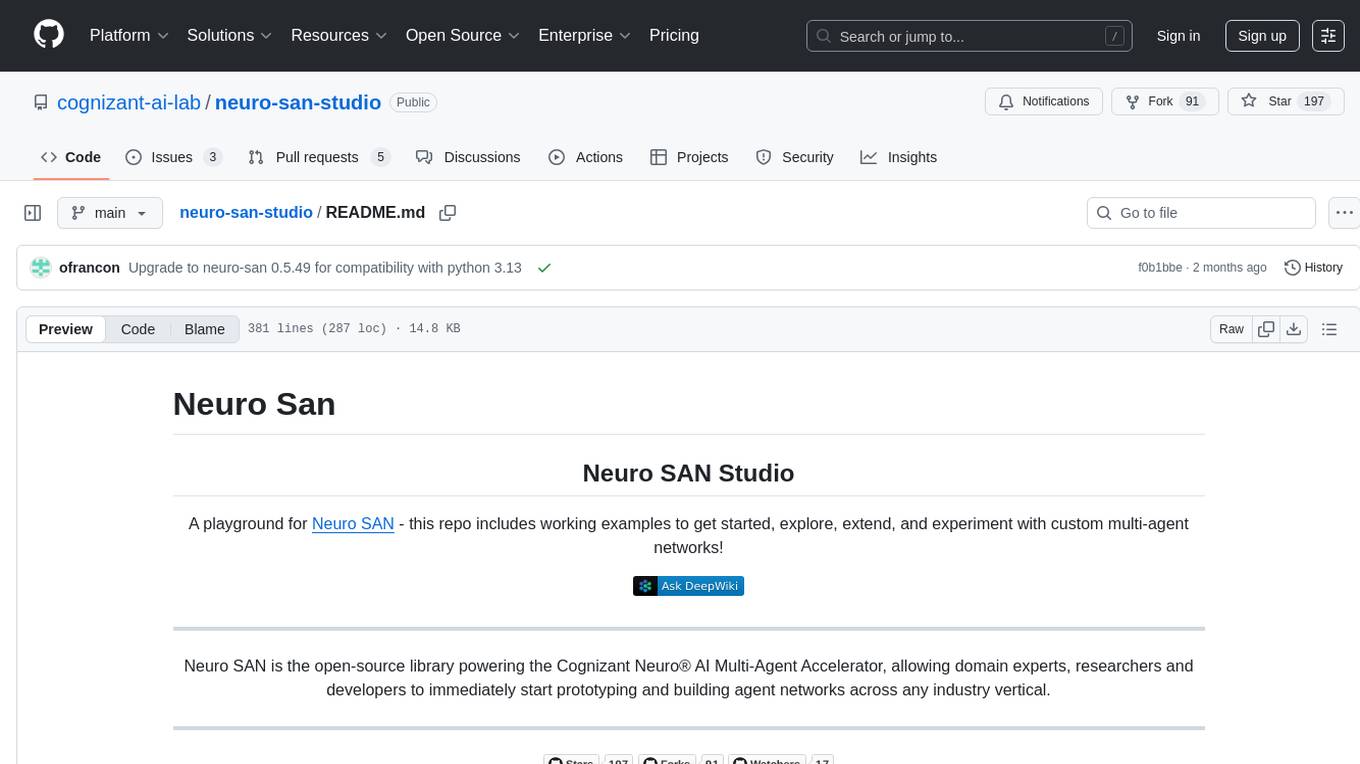
neuro-san-studio
Neuro SAN Studio is an open-source library for building agent networks across various industries. It simplifies the development of collaborative AI systems by enabling users to create sophisticated multi-agent applications using declarative configuration files. The tool offers features like data-driven configuration, adaptive communication protocols, safe data handling, dynamic agent network designer, flexible tool integration, robust traceability, and cloud-agnostic deployment. It has been used in various use-cases such as automated generation of multi-agent configurations, airline policy assistance, banking operations, market analysis in consumer packaged goods, insurance claims processing, intranet knowledge management, retail operations, telco network support, therapy vignette supervision, and more.
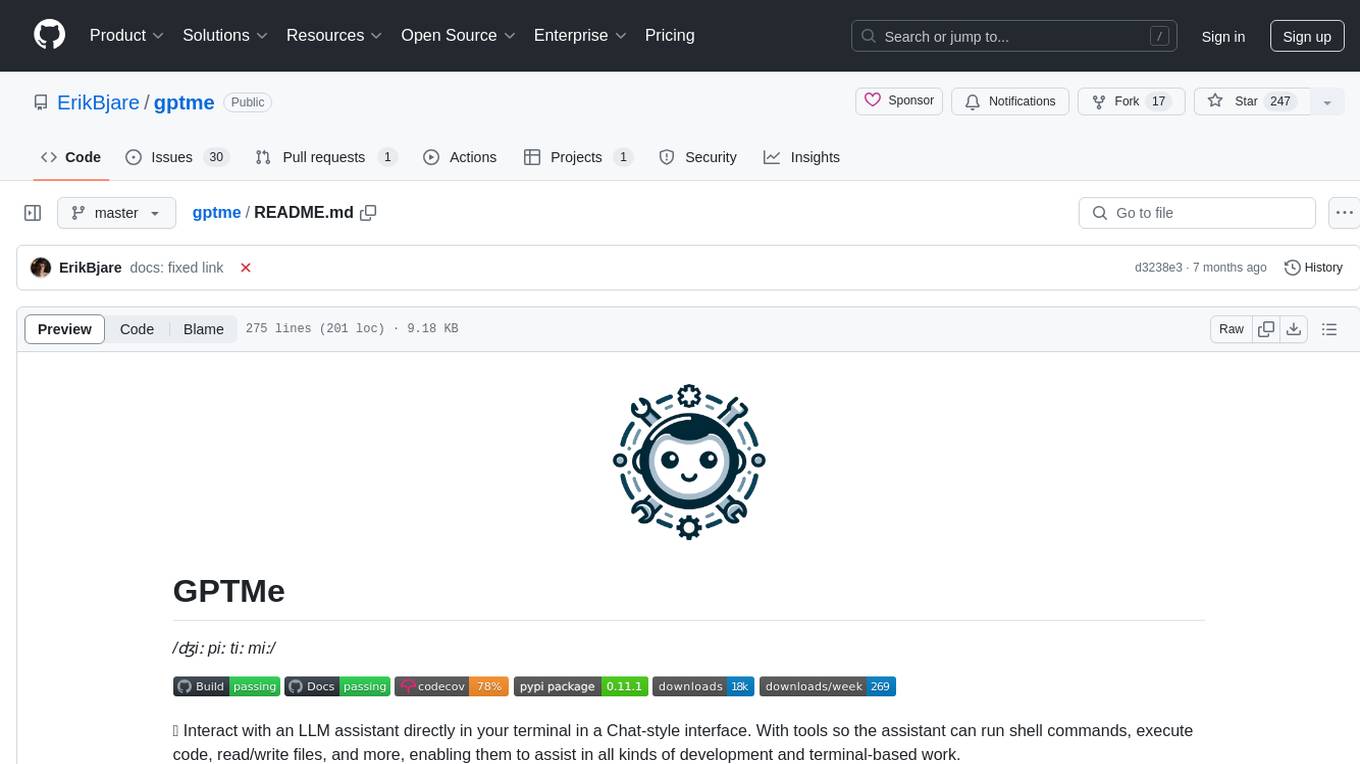
gptme
GPTMe is a tool that allows users to interact with an LLM assistant directly in their terminal in a chat-style interface. The tool provides features for the assistant to run shell commands, execute code, read/write files, and more, making it suitable for various development and terminal-based tasks. It serves as a local alternative to ChatGPT's 'Code Interpreter,' offering flexibility and privacy when using a local model. GPTMe supports code execution, file manipulation, context passing, self-correction, and works with various AI models like GPT-4. It also includes a GitHub Bot for requesting changes and operates entirely in GitHub Actions. In progress features include handling long contexts intelligently, a web UI and API for conversations, web and desktop vision, and a tree-based conversation structure.
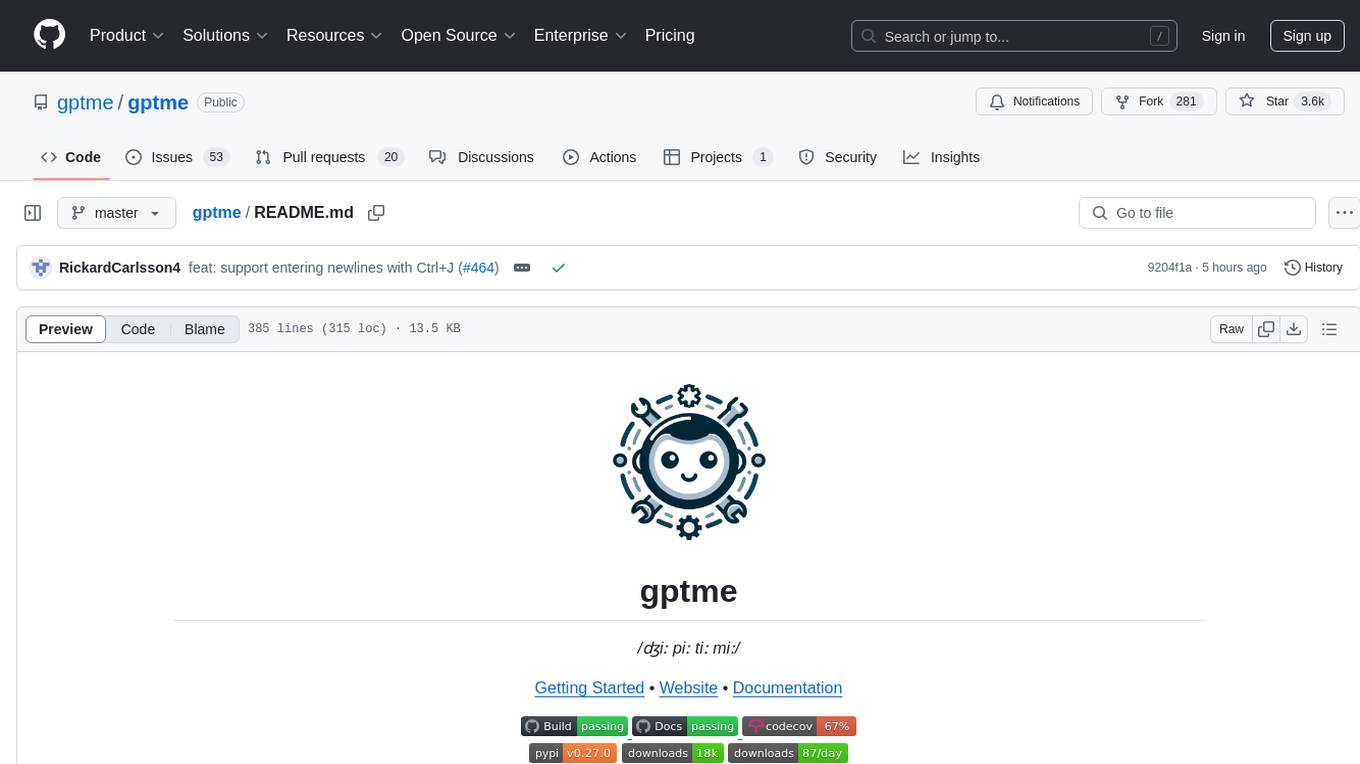
gptme
Personal AI assistant/agent in your terminal, with tools for using the terminal, running code, editing files, browsing the web, using vision, and more. A great coding agent that is general-purpose to assist in all kinds of knowledge work, from a simple but powerful CLI. An unconstrained local alternative to ChatGPT with 'Code Interpreter', Cursor Agent, etc. Not limited by lack of software, internet access, timeouts, or privacy concerns if using local models.
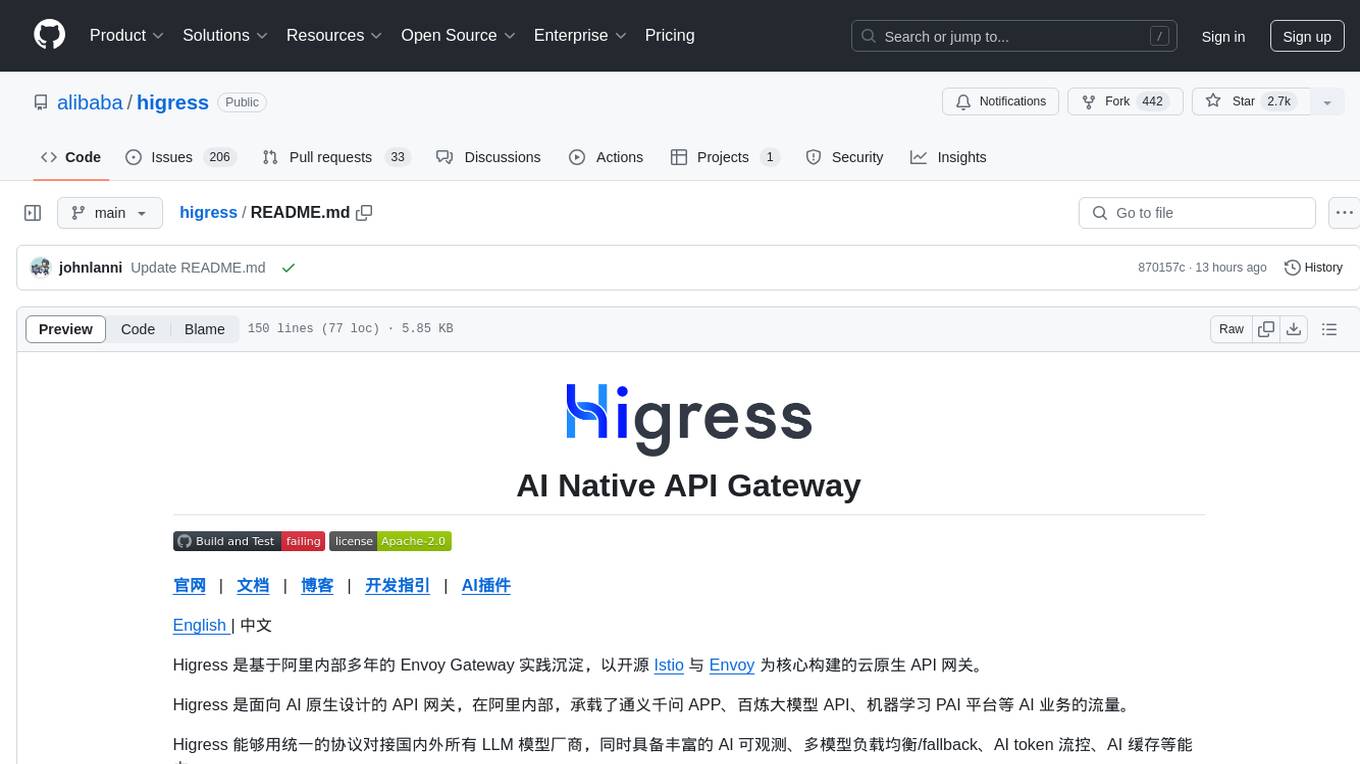
higress
Higress is an open-source cloud-native API gateway built on the core of Istio and Envoy, based on Alibaba's internal practice of Envoy Gateway. It is designed for AI-native API gateway, serving AI businesses such as Tongyi Qianwen APP, Bailian Big Model API, and Machine Learning PAI platform. Higress provides capabilities to interface with LLM model vendors, AI observability, multi-model load balancing/fallback, AI token flow control, and AI caching. It offers features for AI gateway, Kubernetes Ingress gateway, microservices gateway, and security protection gateway, with advantages in production-level scalability, stream processing, extensibility, and ease of use.
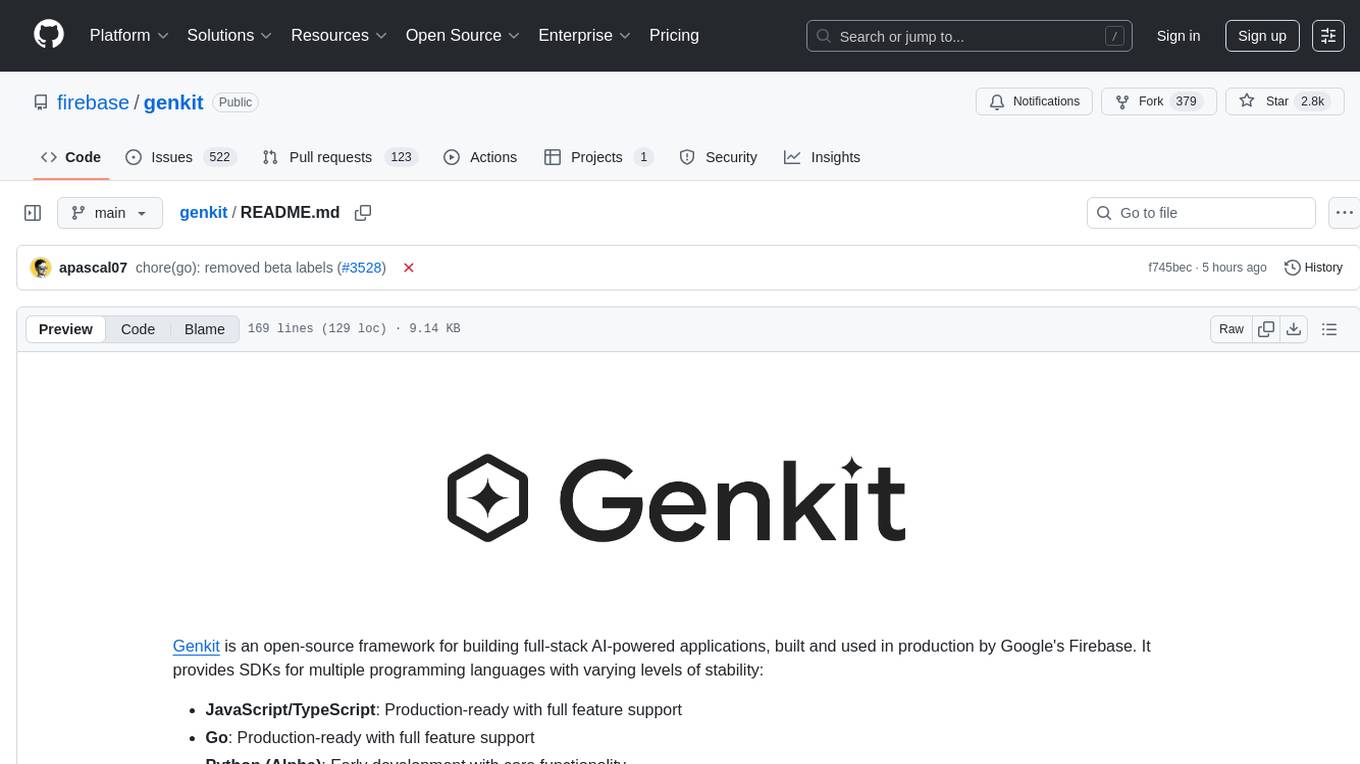
Genkit
Genkit is an open-source framework for building full-stack AI-powered applications, used in production by Google's Firebase. It provides SDKs for JavaScript/TypeScript (Stable), Go (Beta), and Python (Alpha) with unified interface for integrating AI models from providers like Google, OpenAI, Anthropic, Ollama. Rapidly build chatbots, automations, and recommendation systems using streamlined APIs for multimodal content, structured outputs, tool calling, and agentic workflows. Genkit simplifies AI integration with open-source SDK, unified APIs, and offers text and image generation, structured data generation, tool calling, prompt templating, persisted chat interfaces, AI workflows, and AI-powered data retrieval (RAG).
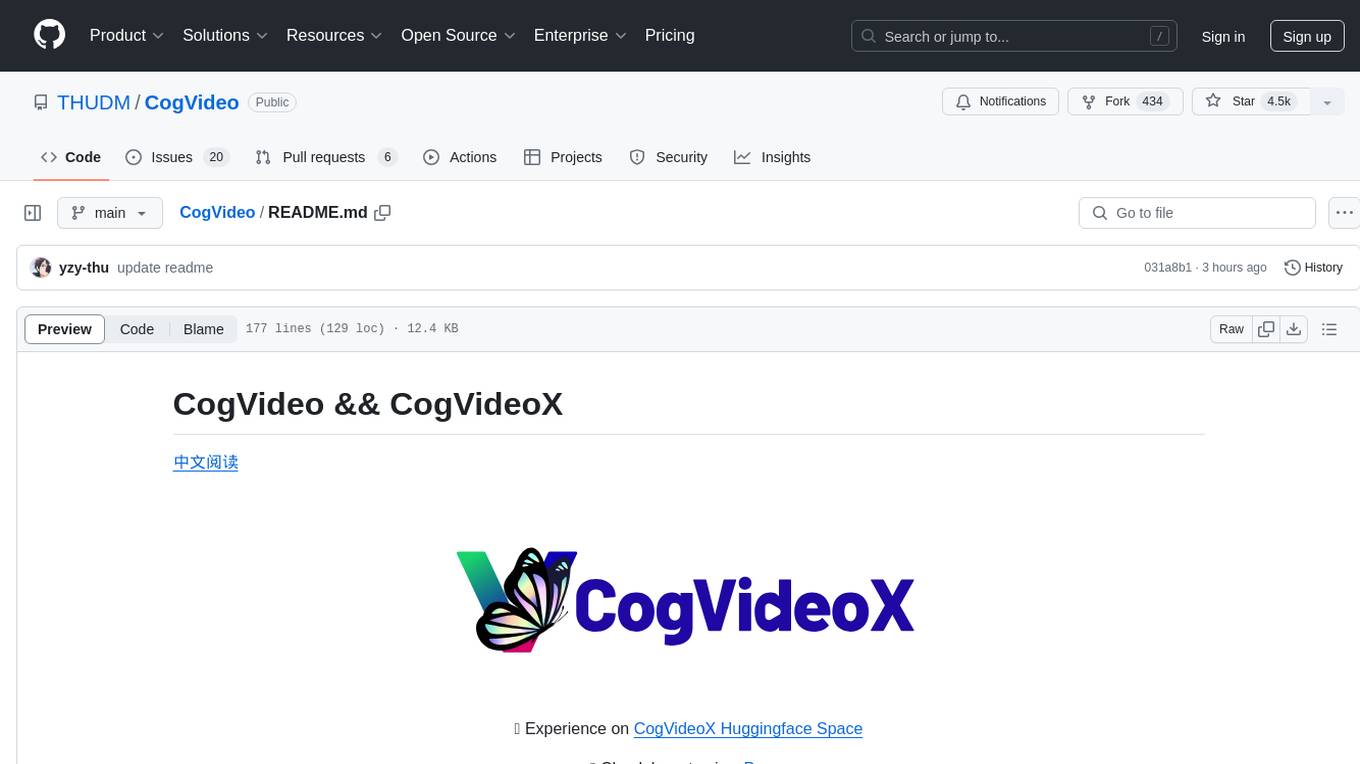
CogVideo
CogVideo is an open-source repository that provides pretrained text-to-video models for generating videos based on input text. It includes models like CogVideoX-2B and CogVideo, offering powerful video generation capabilities. The repository offers tools for inference, fine-tuning, and model conversion, along with demos showcasing the model's capabilities through CLI, web UI, and online experiences. CogVideo aims to facilitate the creation of high-quality videos from textual descriptions, catering to a wide range of applications.
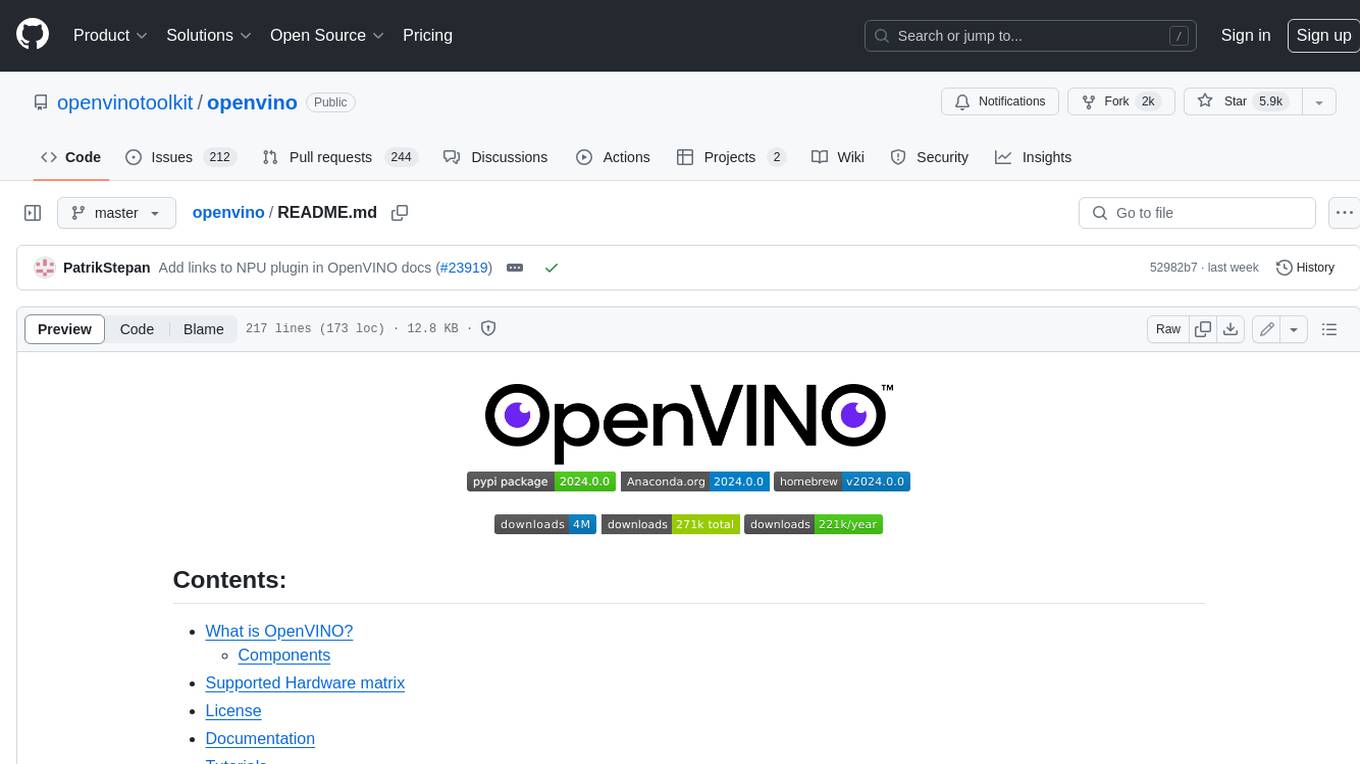
openvino
OpenVINO™ is an open-source toolkit for optimizing and deploying AI inference. It provides a common API to deliver inference solutions on various platforms, including CPU, GPU, NPU, and heterogeneous devices. OpenVINO™ supports pre-trained models from Open Model Zoo and popular frameworks like TensorFlow, PyTorch, and ONNX. Key components of OpenVINO™ include the OpenVINO™ Runtime, plugins for different hardware devices, frontends for reading models from native framework formats, and the OpenVINO Model Converter (OVC) for adjusting models for optimal execution on target devices.
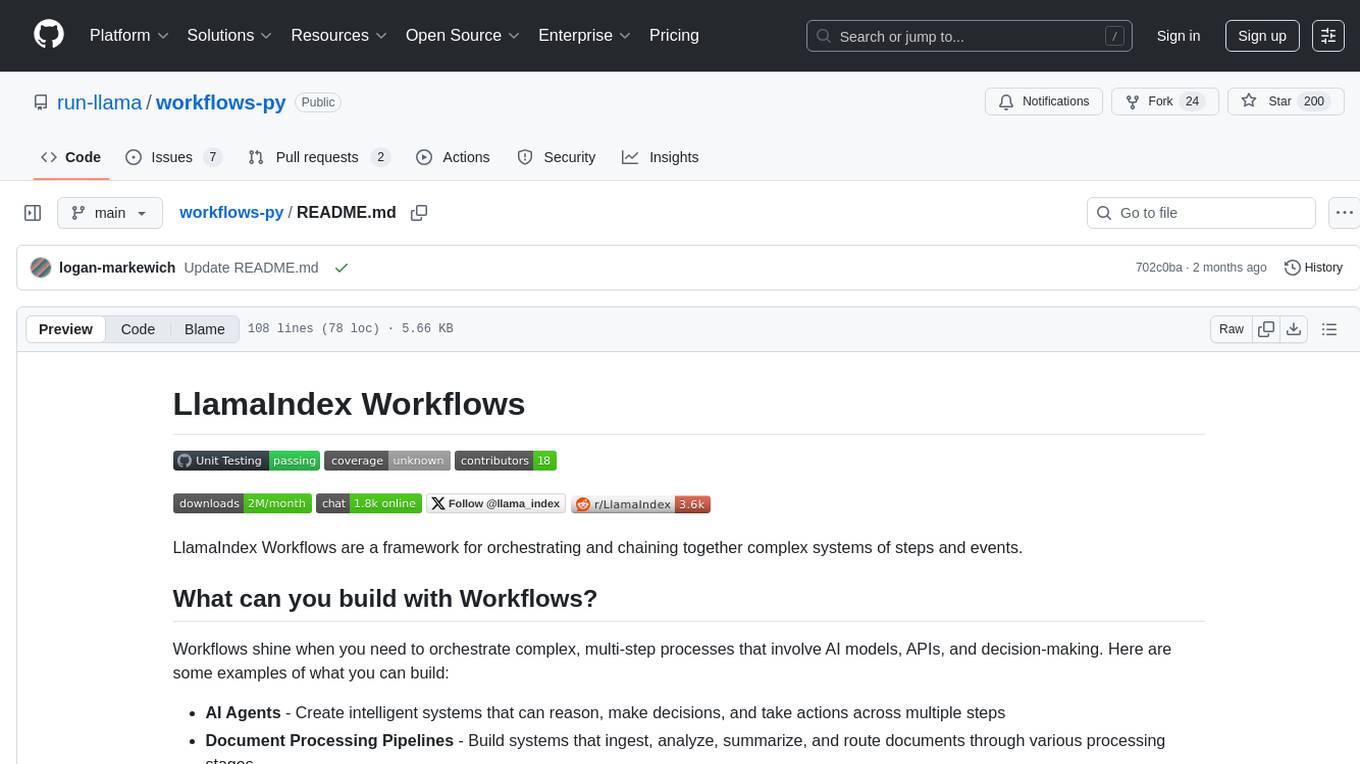
workflows-py
LlamaIndex Workflows is a framework for orchestrating and chaining together complex systems of steps and events. It shines in orchestrating complex, multi-step processes involving AI models, APIs, and decision-making. The async-first, event-driven architecture allows building workflows that can route between different capabilities, implement parallel processing patterns, loop over complex sequences, and maintain state across multiple steps. Key features include async-first design, event-driven structure, state management, and observability through tools like Arize Phoenix and OpenTelemetry.
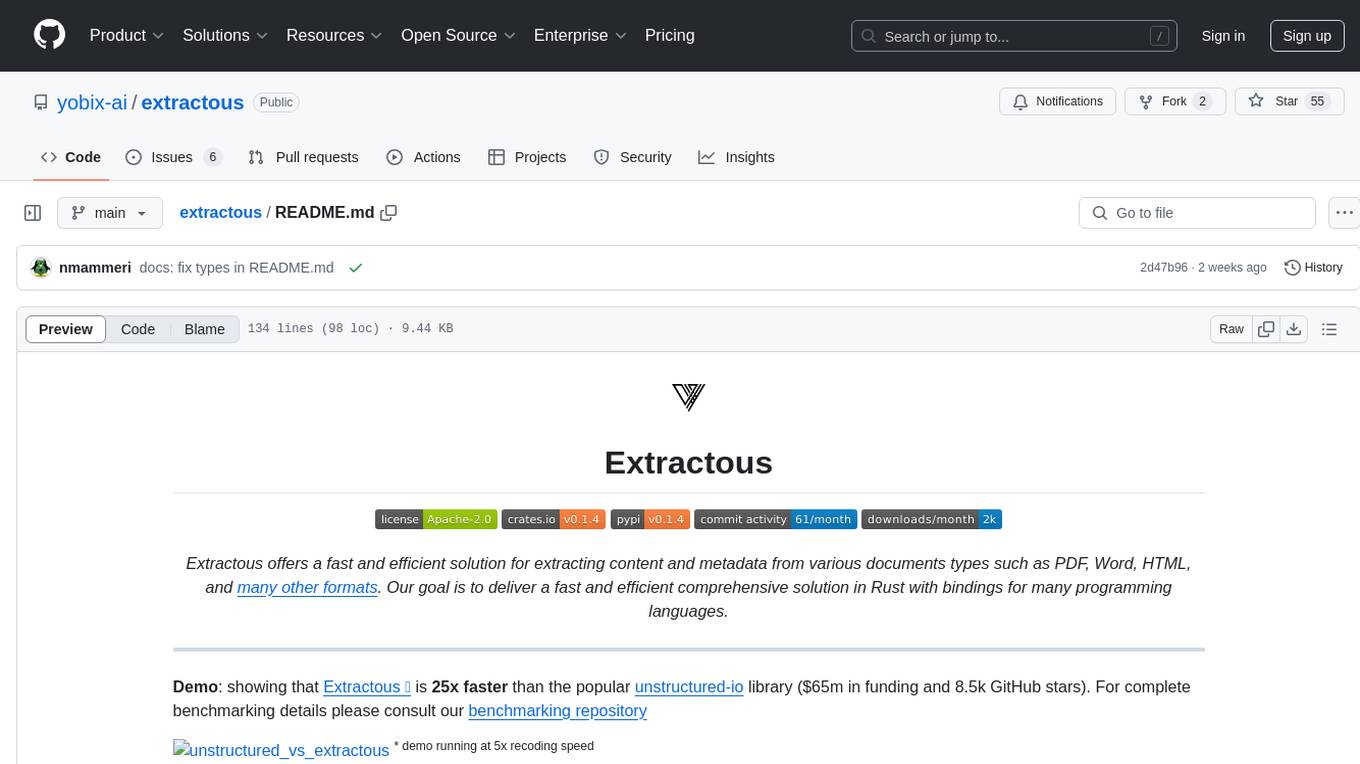
extractous
Extractous offers a fast and efficient solution for extracting content and metadata from various document types such as PDF, Word, HTML, and many other formats. It is built with Rust, providing high performance, memory safety, and multi-threading capabilities. The tool eliminates the need for external services or APIs, making data processing pipelines faster and more efficient. It supports multiple file formats, including Microsoft Office, OpenOffice, PDF, spreadsheets, web documents, e-books, text files, images, and email formats. Extractous provides a clear and simple API for extracting text and metadata content, with upcoming support for JavaScript/TypeScript. It is free for commercial use under the Apache 2.0 License.
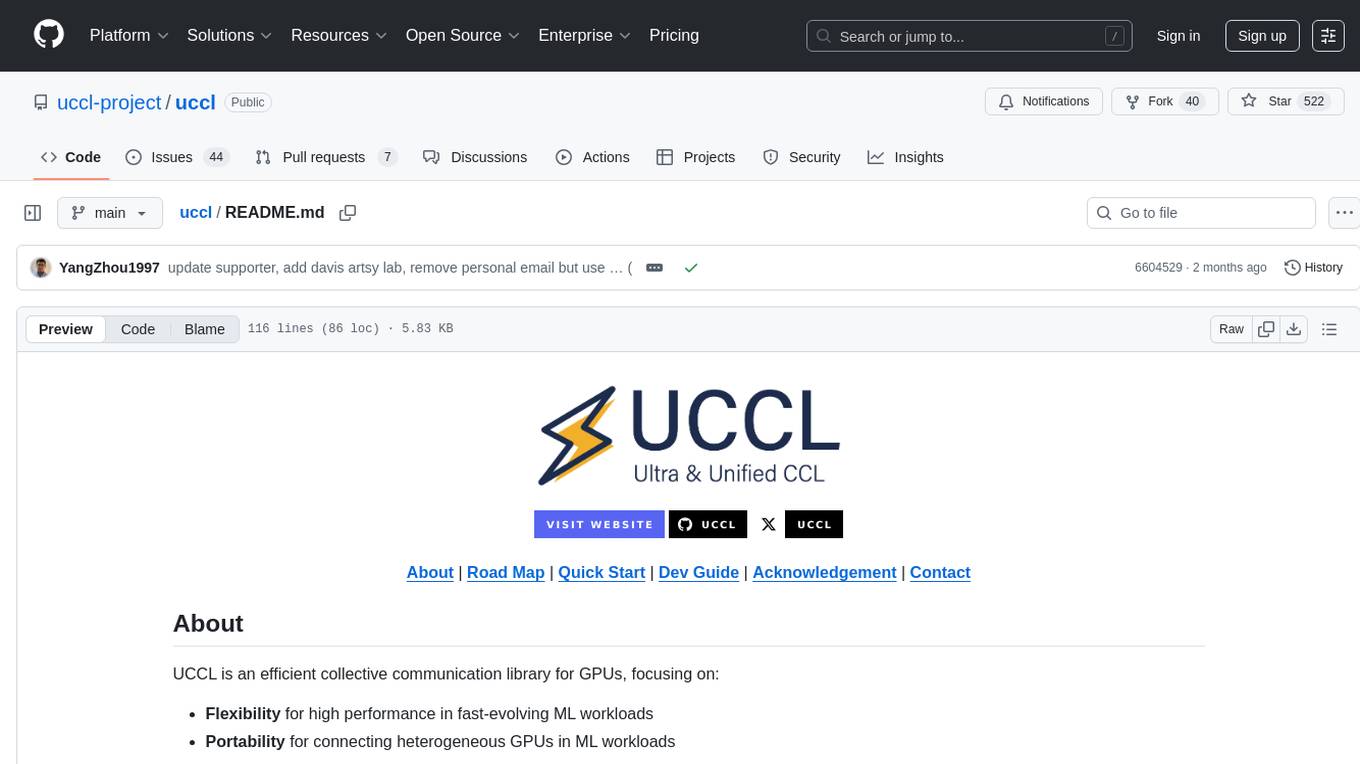
uccl
UCCL is a command-line utility tool designed to simplify the process of converting Unix-style file paths to Windows-style file paths and vice versa. It provides a convenient way for developers and system administrators to handle file path conversions without the need for manual adjustments. With UCCL, users can easily convert file paths between different operating systems, making it a valuable tool for cross-platform development and file management tasks.
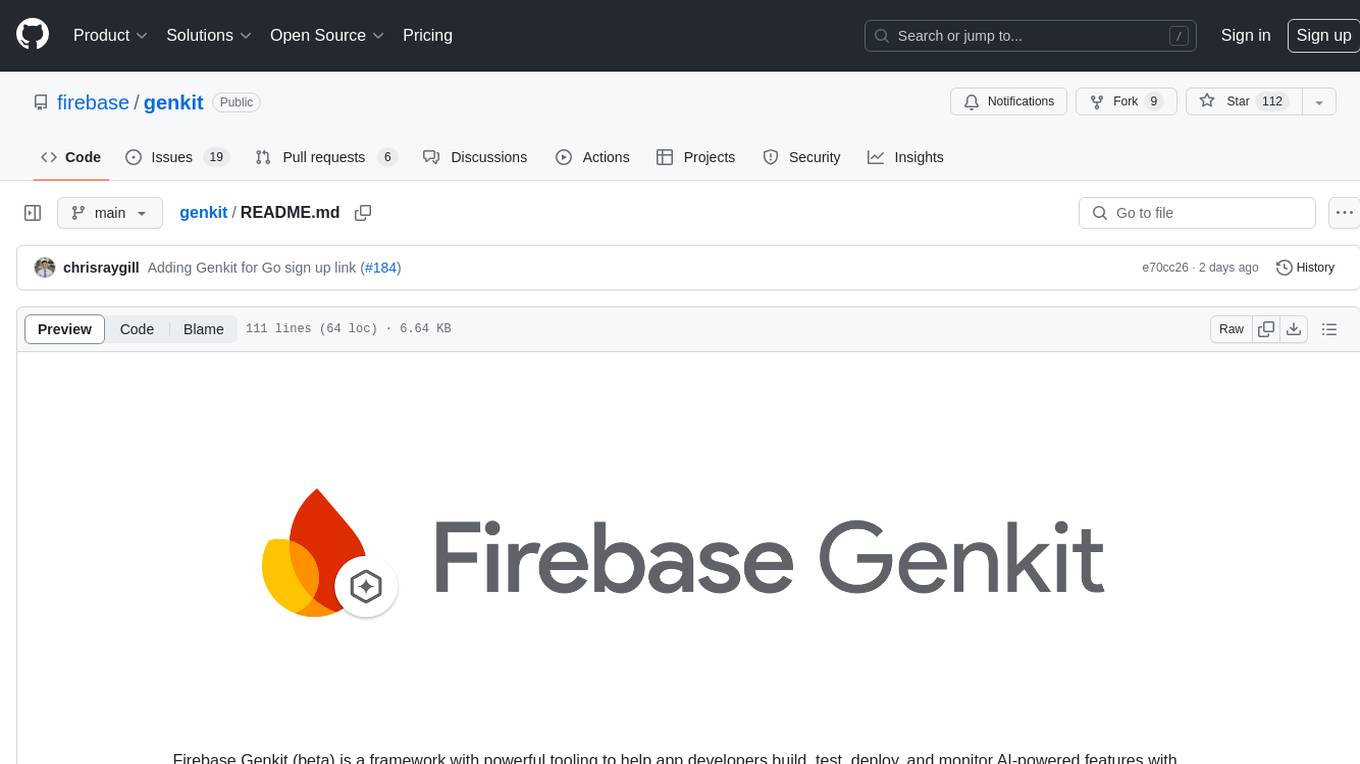
genkit
Firebase Genkit (beta) is a framework with powerful tooling to help app developers build, test, deploy, and monitor AI-powered features with confidence. Genkit is cloud optimized and code-centric, integrating with many services that have free tiers to get started. It provides unified API for generation, context-aware AI features, evaluation of AI workflow, extensibility with plugins, easy deployment to Firebase or Google Cloud, observability and monitoring with OpenTelemetry, and a developer UI for prototyping and testing AI features locally. Genkit works seamlessly with Firebase or Google Cloud projects through official plugins and templates.
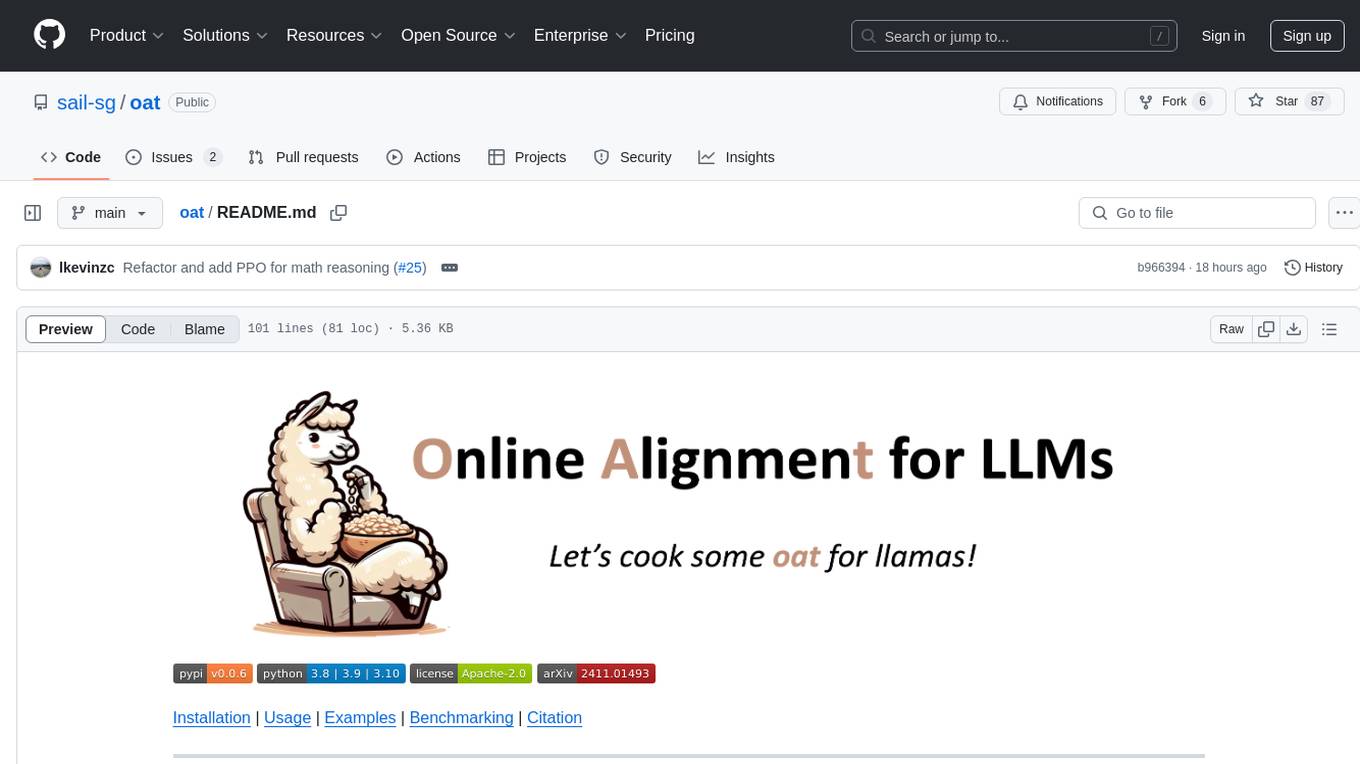
oat
Oat is a simple and efficient framework for running online LLM alignment algorithms. It implements a distributed Actor-Learner-Oracle architecture, with components optimized using state-of-the-art tools. Oat simplifies the experimental pipeline of LLM alignment by serving an Oracle online for preference data labeling and model evaluation. It provides a variety of oracles for simulating feedback and supports verifiable rewards. Oat's modular structure allows for easy inheritance and modification of classes, enabling rapid prototyping and experimentation with new algorithms. The framework implements cutting-edge online algorithms like PPO for math reasoning and various online exploration algorithms.
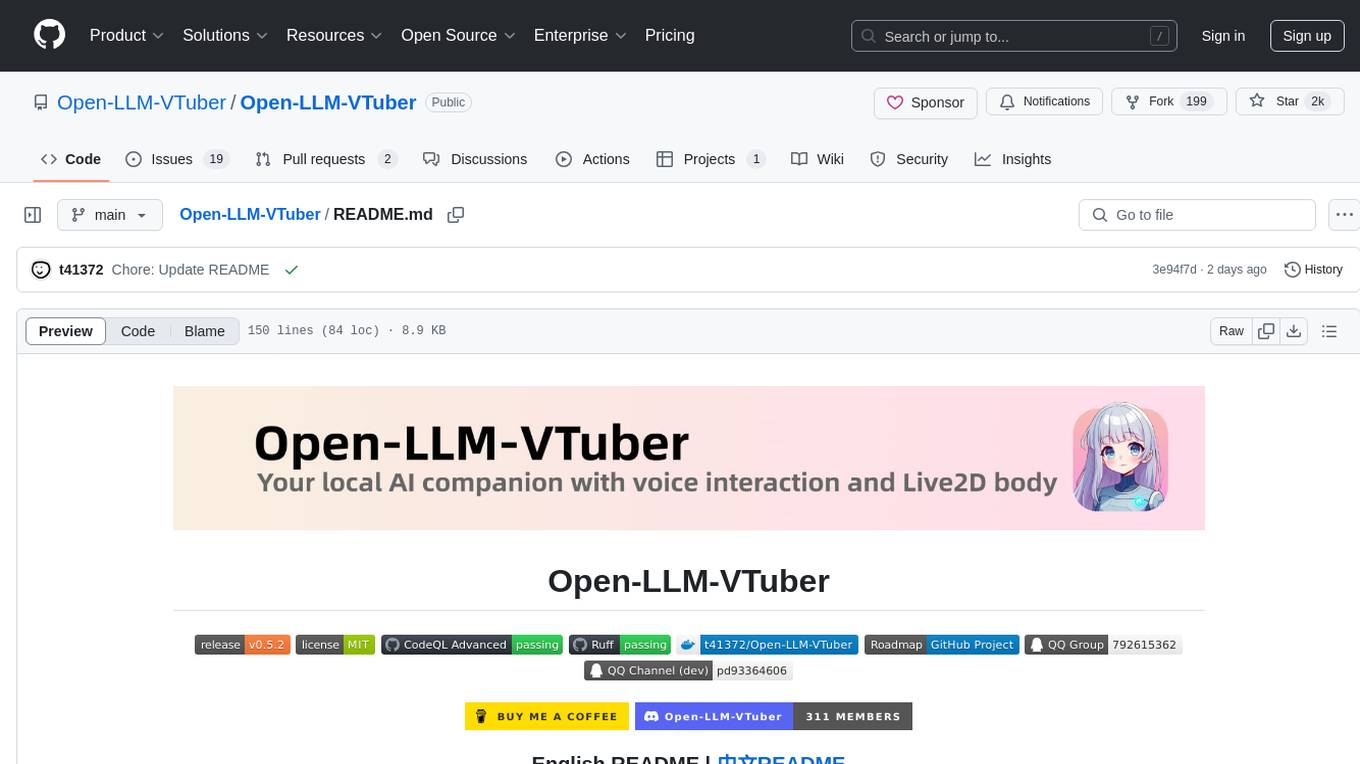
Open-LLM-VTuber
Open-LLM-VTuber is a voice-interactive AI companion supporting real-time voice conversations and featuring a Live2D avatar. It can run offline on Windows, macOS, and Linux, offering web and desktop client modes. Users can customize appearance and persona, with rich LLM inference, text-to-speech, and speech recognition support. The project is highly customizable, extensible, and actively developed with exciting features planned. It provides privacy with offline mode, persistent chat logs, and various interaction features like voice interruption, touch feedback, Live2D expressions, pet mode, and more.
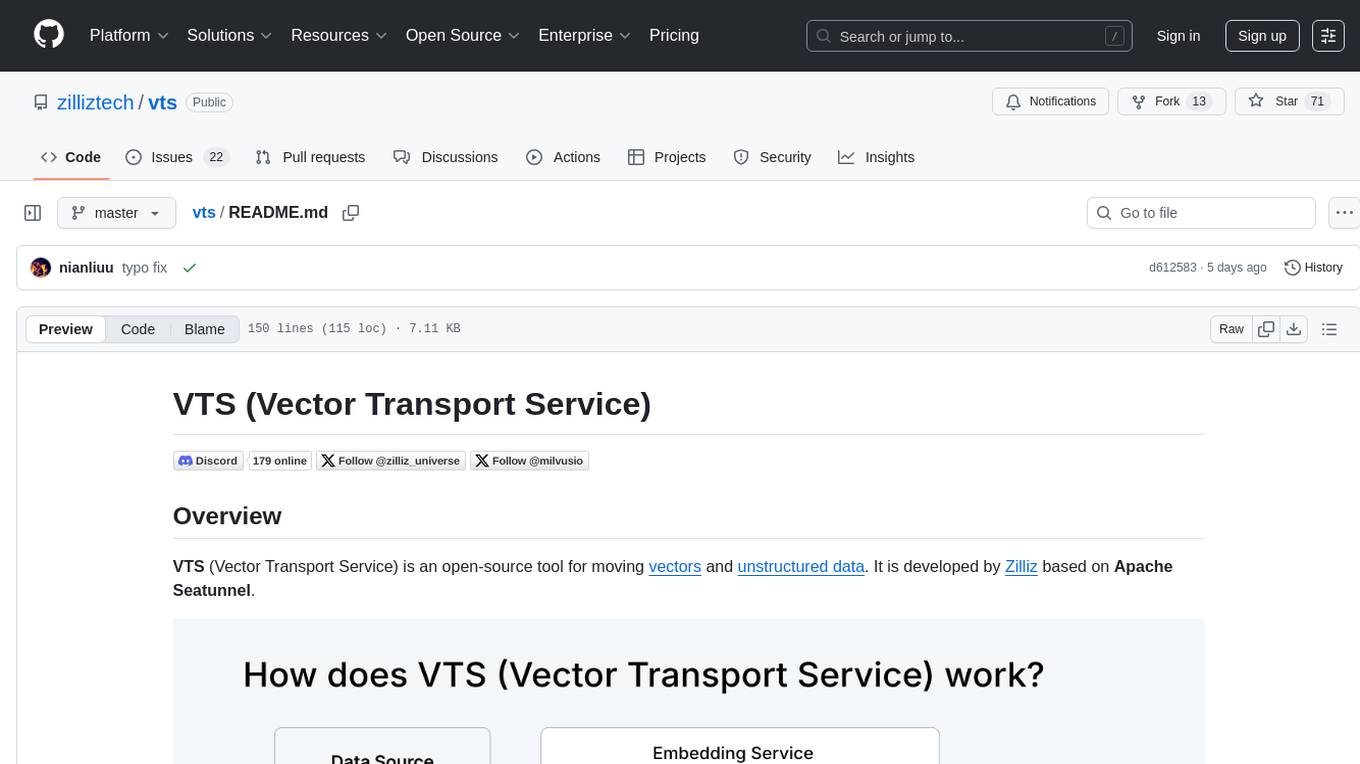
vts
VTS (Vector Transport Service) is an open-source tool developed by Zilliz based on Apache Seatunnel for moving vectors and unstructured data. It addresses data migration needs, supports real-time data streaming and offline import, simplifies unstructured data transformation, and ensures end-to-end data quality. Core capabilities include rich connectors, stream and batch processing, distributed snapshot support, high performance, and real-time monitoring. Future developments include incremental synchronization, advanced data transformation, and enhanced monitoring. VTS supports various connectors for data migration and offers advanced features like Transformers, cluster mode deployment, RESTful API, Docker deployment, and more.
For similar tasks

aistore
AIStore is a lightweight object storage system designed for AI applications. It is highly scalable, reliable, and easy to use. AIStore can be deployed on any commodity hardware, and it can be used to store and manage large datasets for deep learning and other AI applications.
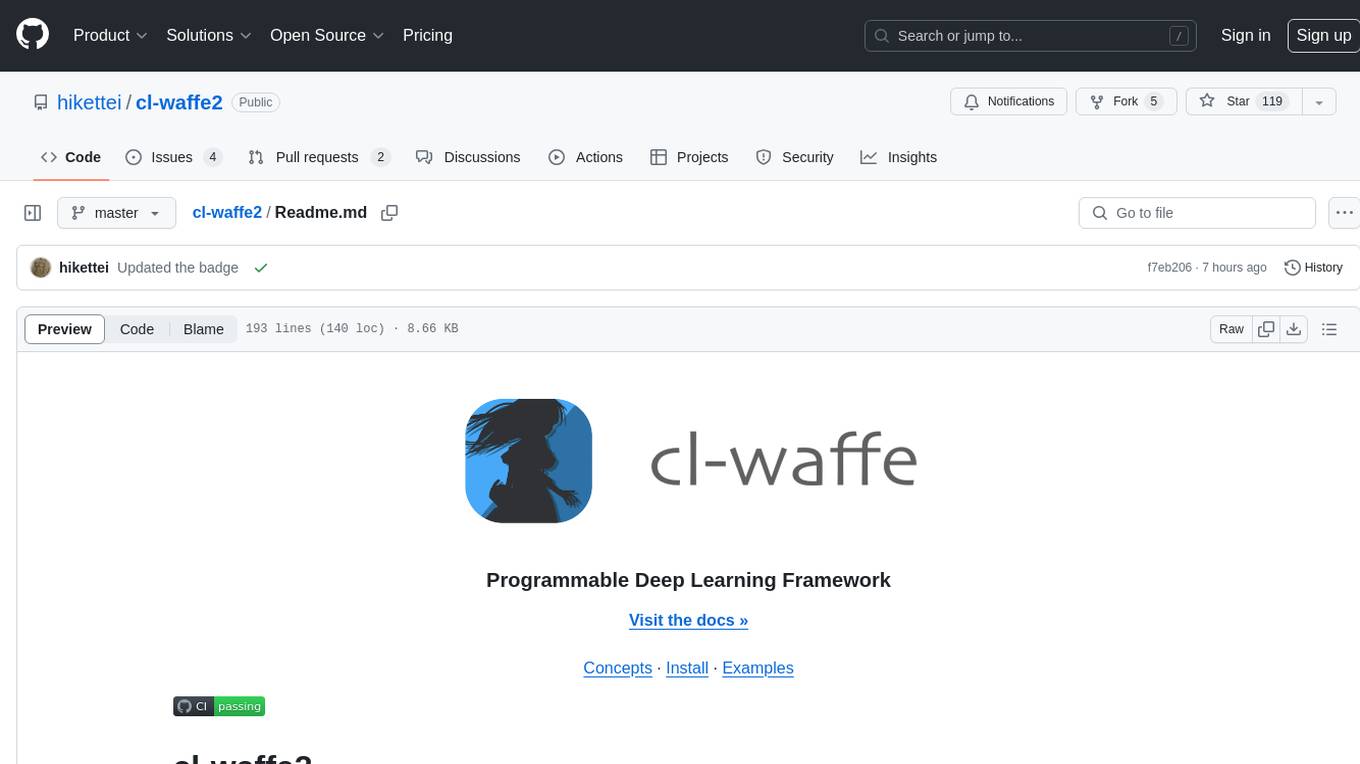
cl-waffe2
cl-waffe2 is an experimental deep learning framework in Common Lisp, providing fast, systematic, and customizable matrix operations, reverse mode tape-based Automatic Differentiation, and neural network model building and training features accelerated by a JIT Compiler. It offers abstraction layers, extensibility, inlining, graph-level optimization, visualization, debugging, systematic nodes, and symbolic differentiation. Users can easily write extensions and optimize their networks without overheads. The framework is designed to eliminate barriers between users and developers, allowing for easy customization and extension.
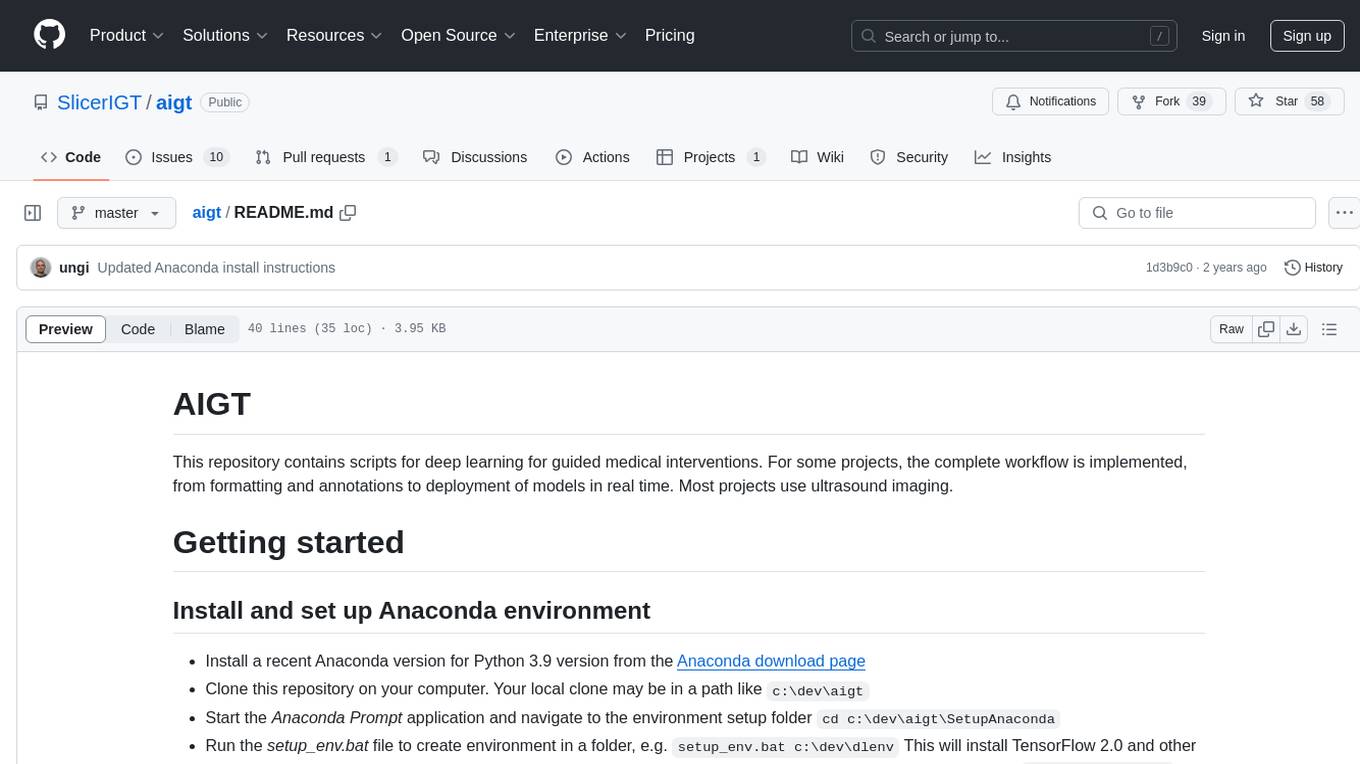
aigt
AIGT is a repository containing scripts for deep learning in guided medical interventions, focusing on ultrasound imaging. It provides a complete workflow from formatting and annotations to real-time model deployment. Users can set up an Anaconda environment, run Slicer notebooks, acquire tracked ultrasound data, and process exported data for training. The repository includes tools for segmentation, image export, and annotation creation.
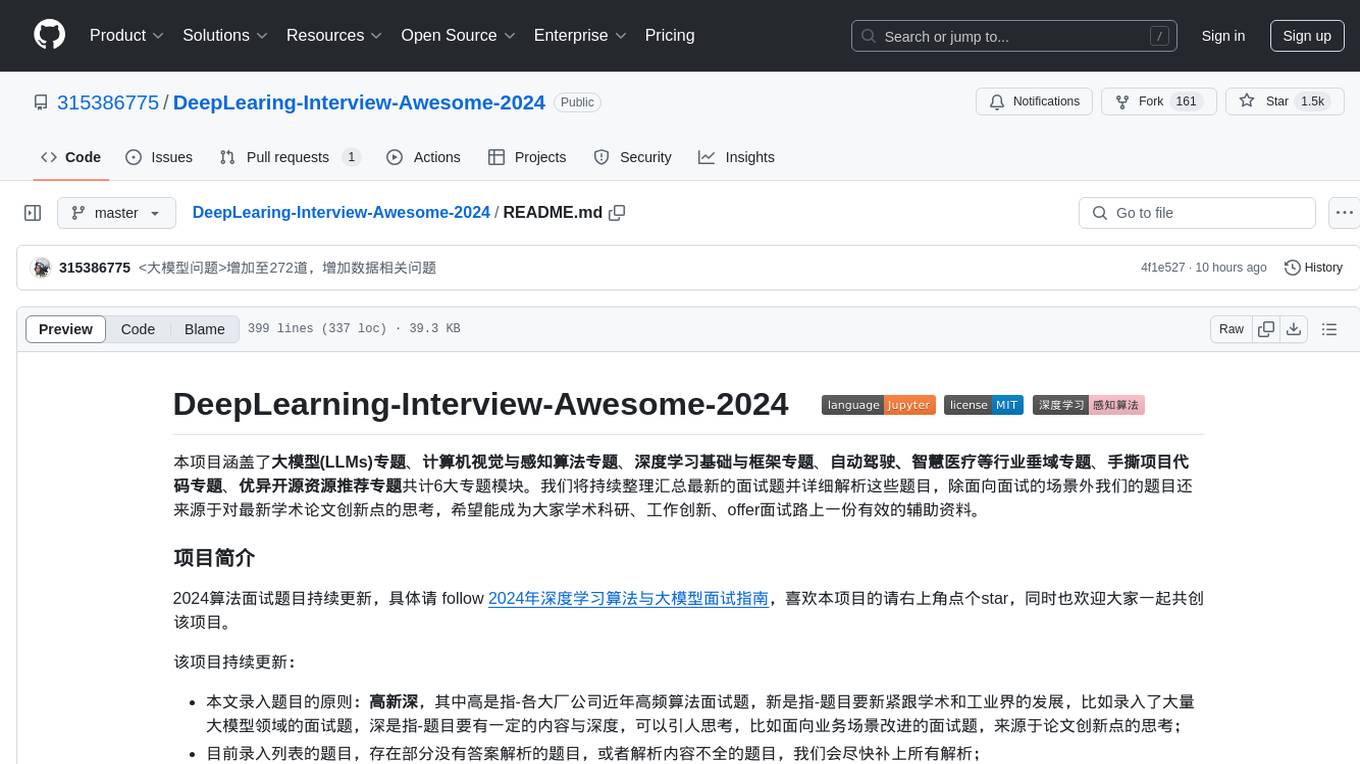
DeepLearing-Interview-Awesome-2024
DeepLearning-Interview-Awesome-2024 is a repository that covers various topics related to deep learning, computer vision, big models (LLMs), autonomous driving, smart healthcare, and more. It provides a collection of interview questions with detailed explanations sourced from recent academic papers and industry developments. The repository is aimed at assisting individuals in academic research, work innovation, and job interviews. It includes six major modules covering topics such as large language models (LLMs), computer vision models, common problems in computer vision and perception algorithms, deep learning basics and frameworks, as well as specific tasks like 3D object detection, medical image segmentation, and more.
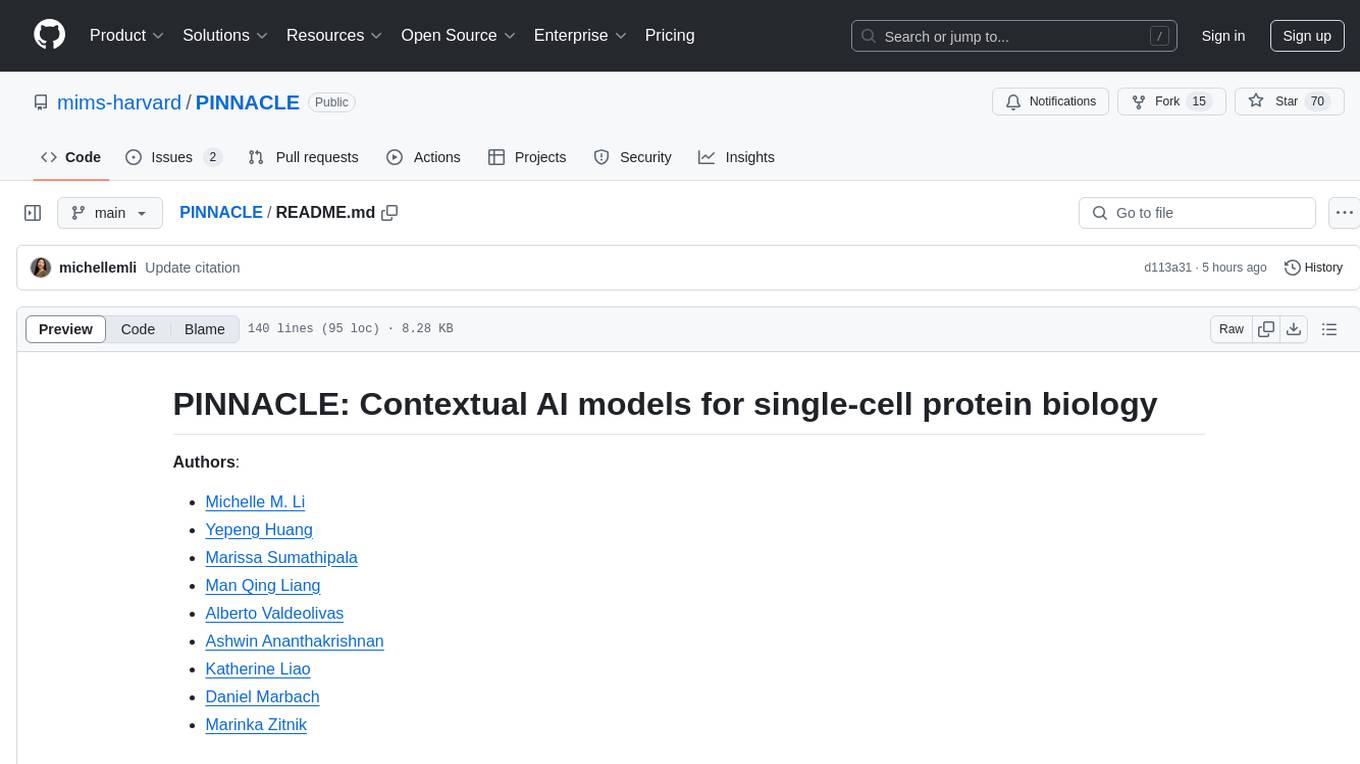
PINNACLE
PINNACLE is a flexible geometric deep learning approach that trains on contextualized protein interaction networks to generate context-aware protein representations. It provides protein representations split across various cell-type contexts from different tissues and organs. The tool can be fine-tuned to study the genomic effects of drugs and nominate promising protein targets and cell-type contexts for further investigation. PINNACLE exemplifies the paradigm of incorporating context-specific effects for studying biological systems, especially the impact of disease and therapeutics.
For similar jobs

weave
Weave is a toolkit for developing Generative AI applications, built by Weights & Biases. With Weave, you can log and debug language model inputs, outputs, and traces; build rigorous, apples-to-apples evaluations for language model use cases; and organize all the information generated across the LLM workflow, from experimentation to evaluations to production. Weave aims to bring rigor, best-practices, and composability to the inherently experimental process of developing Generative AI software, without introducing cognitive overhead.

LLMStack
LLMStack is a no-code platform for building generative AI agents, workflows, and chatbots. It allows users to connect their own data, internal tools, and GPT-powered models without any coding experience. LLMStack can be deployed to the cloud or on-premise and can be accessed via HTTP API or triggered from Slack or Discord.

VisionCraft
The VisionCraft API is a free API for using over 100 different AI models. From images to sound.

kaito
Kaito is an operator that automates the AI/ML inference model deployment in a Kubernetes cluster. It manages large model files using container images, avoids tuning deployment parameters to fit GPU hardware by providing preset configurations, auto-provisions GPU nodes based on model requirements, and hosts large model images in the public Microsoft Container Registry (MCR) if the license allows. Using Kaito, the workflow of onboarding large AI inference models in Kubernetes is largely simplified.

PyRIT
PyRIT is an open access automation framework designed to empower security professionals and ML engineers to red team foundation models and their applications. It automates AI Red Teaming tasks to allow operators to focus on more complicated and time-consuming tasks and can also identify security harms such as misuse (e.g., malware generation, jailbreaking), and privacy harms (e.g., identity theft). The goal is to allow researchers to have a baseline of how well their model and entire inference pipeline is doing against different harm categories and to be able to compare that baseline to future iterations of their model. This allows them to have empirical data on how well their model is doing today, and detect any degradation of performance based on future improvements.

tabby
Tabby is a self-hosted AI coding assistant, offering an open-source and on-premises alternative to GitHub Copilot. It boasts several key features: * Self-contained, with no need for a DBMS or cloud service. * OpenAPI interface, easy to integrate with existing infrastructure (e.g Cloud IDE). * Supports consumer-grade GPUs.

spear
SPEAR (Simulator for Photorealistic Embodied AI Research) is a powerful tool for training embodied agents. It features 300 unique virtual indoor environments with 2,566 unique rooms and 17,234 unique objects that can be manipulated individually. Each environment is designed by a professional artist and features detailed geometry, photorealistic materials, and a unique floor plan and object layout. SPEAR is implemented as Unreal Engine assets and provides an OpenAI Gym interface for interacting with the environments via Python.

Magick
Magick is a groundbreaking visual AIDE (Artificial Intelligence Development Environment) for no-code data pipelines and multimodal agents. Magick can connect to other services and comes with nodes and templates well-suited for intelligent agents, chatbots, complex reasoning systems and realistic characters.


